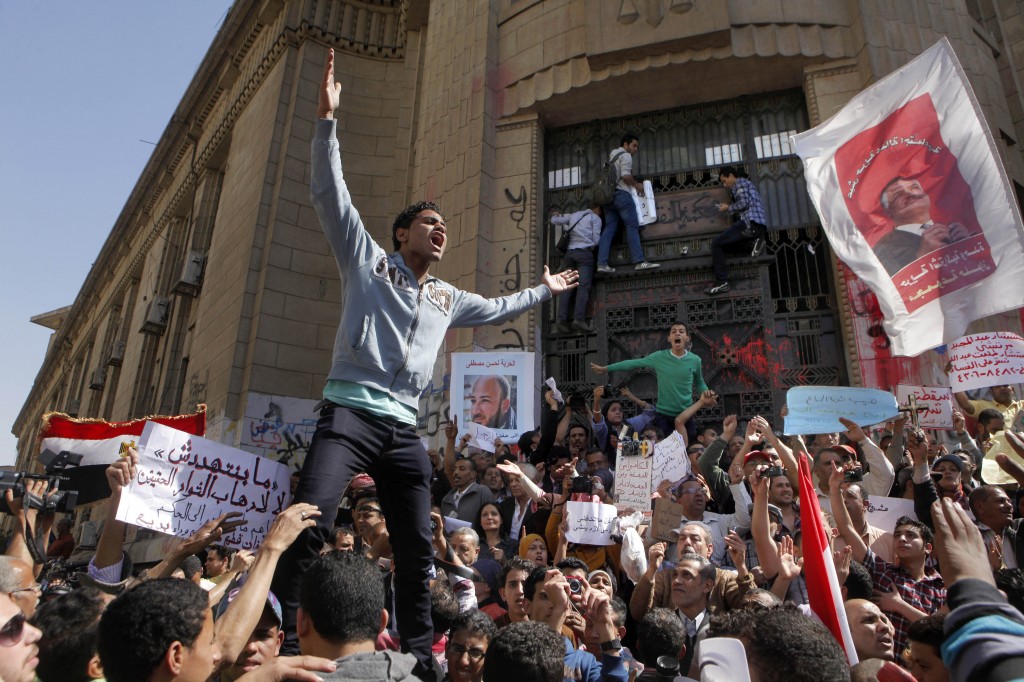An unrivalled eruption of public unrest and dissent rippled across the Cariene streets in February 1968. This was a student uprising that would constitute the most vocal expression of public opposition following the defeat of the 1967 Arab-Israeli War. A series of organised student strikes, demonstrations and sit-ins that year mounted increasing pressures on Gamal Abdel Nasser’s weakening regime.
Student movements started to rapidly evolve, and became at the forefront of “challenging the state monopoly over public space” throughout Egypt’s contemporary political history.
Following Egyptian President Anwar El Sadat’s ascent to power, a new form of student activism was on the rise. Sadat’s policies to support the establishment of Islamic student organisations on college campuses had created a new stratum of young activists. These Islamic student groups, known as al-Gama’a al-Islamiyya (the Islamic Community), immediately gained traction and were extremely influential political organisations in Egyptian universities.
According to John Esposito, a leading scholar of Middle Eastern and Religious Studies at Georgetown University, Sadat initially promoted Islamic student organisations as a means to “bolster his image as the ‘believer president’ and challenge the influence of the Arab secular nationalist ideology” evoked by his predecessor, the late Gamal Abdel Nasser.
A wave of burgeoning Islamic activism was cultivated in courtyards and hallways in universities across the country, and opposition to Sadat’s policies grew ever more fervent.
Sadat’s pro-Western economic policies and his decision to sign a peace agreement with Israel angered these powerful Islamic groups. He was accused of having sold out both Egypt and his Islamic values to become a puppet of Western allies.
Price hikes and crushing austerity measures resulting from Sadat’s liberal economic policies strained Egypt’s working classes, and added more fuel to the flames. In 1979, public outrage resulted in a series of protests that culminated in Intifadat Al-Khobz – or the Bread Intifada.
The growth of vocal and active Islamic groups had shaken the political core of Sadat’s regime. A crackdown on Islamic student groups would soon begin, along with arrests in several sectors of society that were deemed a threat to political stability. Esposito confirms that “the process reached its apogee in 1981, when Sadat imprisoned more than 1,500 people from a cross section of Egyptian society: Islamic activists, lawyers, doctors, journalists, university professors, political opponents, and ex-government ministers”.
Mass imprisonments led to the increased radicalisation and the rise of clandestine militant cells that would plot to overthrow Sadat’s regime.
On 6 October 1981, Islamic militants assassinated Sadat during a military parade, bringing civil unrest to a crescendo.
However, despite increased government control over student unions and movements, political unrest and dissatisfaction continued to emanate from universities.
President Hosni Mubarak would not fall victim to the ills of his predecessor, and played a proactive role in suppressing any overt political activity in Egypt’s universities. Student demonstrations became increasingly sporadic, and often subject to an array of violent oppression. The Mubarak regime responded with tear gas, rubber bullets, and mass arrests, particularly when protests escalated into violent riots.
The advent of social media, however, enabled the youth to spread messages of resistance beyond university campuses. It also created a safe space where activists could plan, organise and carry out demonstrations in a cohesive manner.
In January 2011, social media would help pave the way for student groups to lead the 25th January Revolution. Tens of thousands would join the youth movement calling for Mubarak’s removal.
He stepped down after just 18 days of protest.
Today, Egypt is once again subject to political suppression on university campuses which are now, after five decades, considered notorious hubs of civil disobedience and unrest. However, the question remains whether Abdel Fattah Al-Sisi’s regime will continue to marginalise the youth, or embrace student activism which has become part and parcel of Egypt’s evolving political environment.







Comment (1)
[…] عدد لا يحصى من الصحوات الشبابية في مصر رودوبيس: أول سندريلا في التاريخ؟ […]